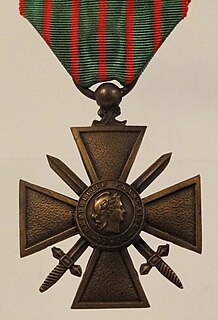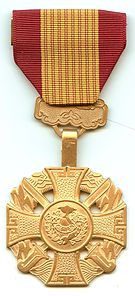The Commendation Medal is a mid-level United States military decoration which is presented for sustained acts of heroism or meritorious service. For valorous actions in direct contact with an enemy, but of a lesser degree than required for the award of the Bronze Star Medal, a Commendation Medal with "V" Device or Combat "V" is awarded; the "V" device may be authorized for wear on the service and suspension ribbon of the medal to denote valor. On January 7 2016, The "C" Device or Combat "C” was created and may be authorized for wear on the service and suspension ribbon of the Commendation Medal to distinguish an award for meritorious service or achievement under the most arduous combat conditions. A Commendation Medal with Combat Device is unofficially named the “Combat Commendation” and is often considered to be a higher level form of the Commendation Medal, regardless of the Awarding Branch. Retroactive award of the “C” device is not approved for medals awarded before 7 January 2016. Each branch of the United States Armed Forces issues its own version of the Commendation Medal, with a fifth version existing for acts of joint military service performed under the Department of Defense.

The Croix de Guerre is a military decoration of France. It was first created in 1915 and consists of a square-cross medal on two crossed swords, hanging from a ribbon with various degree pins. The decoration was awarded during World War I, again in World War II, and in other conflicts. The Croix de Guerre was also commonly bestowed on foreign military forces allied to France.

The United States Armed Forces awards and decorations are primarily the medals, service ribbons, and specific badges which recognize military service and personal accomplishments while a member of the U.S. Armed Forces. Such awards are a means to outwardly display the highlights of a service member's career.
The Valorous Unit Award (VUA) is the second highest United States military unit decoration which may be bestowed upon a military unit after the Presidential Unit Citation (PUC). The VUA is awarded by the United States Army to units of the United States Armed Forces or cobelligerent nations which display extraordinary heroism in action against an armed enemy of the United States on or after 3 August 1963. The unit degree of heroism required is considered the equivalent of the individual degree of heroism required for the Silver Star which is awarded for gallantry in action.

The Republic of Vietnam Campaign Medal also known as the Vietnam Campaign Medal is a military campaign medal which was created in 1949, and awarded to French military personnel during the First Indochina War. During the Vietnam War, the South Vietnamese government awarded the Republic of Vietnam Campaign Medal with Device to members of the South Vietnamese military for wartime service and on March 24, 1966, to members of the U.S. military for support of operations in Vietnam. In May 1966, other allied foreign military personnel became eligible for the award.
The Vietnam Service Medal is a military award of the United States Armed Forces established on 8 July 1965 by order of President Lyndon B. Johnson. The medal is awarded to recognize service during the Vietnam War by all members of the United States Armed Forces provided they meet the award requirements.
The Military Merit Medal was the highest military decoration bestowed to enlisted personnel by the Republic of Vietnam during the years of the Vietnam War. The medal was established on August 15, 1950. The Military Merit Medal was modeled after the French Médaille Militaire and was awarded mostly to Enlisted Men for valor in combat. The Vietnamese National Order of Vietnam was considered the equivalent decoration for military officers.

A service star is a miniature bronze or silver five-pointed star 3⁄16 inch in diameter that is authorized to be worn by members of the seven uniformed services of the United States on medals and ribbons to denote an additional award or service period. The service star may also be referred to as a campaign star or battle star depending on which award is authorized the star and the manner in which the device is used for the award.
The Citation Star was a Department of War personal valor decoration issued as a ribbon device which was first established by the United States Congress on July 9, 1918. When awarded, a 3⁄16-inch (4.8 mm) silver star was placed on the suspension ribbon and service ribbon of the World War I Victory Medal to denote a Citation (certificate) for "Gallantry In Action" was awarded to a soldier, or to a marine or attached to the Army's Second Division, American Expeditionary Forces. The Citation Star was replaced in 1932 with the introduction of the Silver Star Medal.

The Republic of Vietnam Civil Actions Medal also known as the Vietnam Civil Actions Medal or Civil Actions Medal, is a military decoration of the former South Vietnamese government (1955–75). The medal was created on May 12, 1964 during the Vietnam War. The Civil Actions Medal was awarded to the South Vietnamese military and its allies' military personnel or units that performed outstanding achievements in the field of civil affairs. The medal was awarded in two classes, with the first class intended for commissioned officers and the second class for enlisted personnel. Individuals who were cited received the medal, ribbon, and a citation.

Campaign streamers are decorations attached to military flags to recognize particular achievements or events of a military unit or service. Attached to the headpiece of the assigned flag, the streamer often is an inscribed ribbon with the name and date denoting participation in a particular battle, military campaign, or theater of war; the ribbon's colors are chosen accordingly and frequently match an associated campaign medal or ribbon bar. They often are physical manifestations of battle honours, though this does not mean all streamers are battle honours. They should not be confused with a tassel, which is usually purely decorative in nature.

The fourragère is a military award, distinguishing military units as a whole, in the form of a braided cord. The award was first adopted by France, followed by other nations such as the Netherlands, Belgium, Portugal, and Luxembourg. Fourragères have been awarded to units of both national and foreign militaries, except for that of Luxembourg, which has not been awarded to any foreign units.
George J. Walker served as an officer in the U.S. Army, including a stint in 1985 as Deputy Commanding General of the United States Army Intelligence and Security Command(INSCOM).
Authorized foreign decorations of the United States military are those military decorations which have been approved for wear by members of the United States armed forces but whose awarding authority is the government of a country other than the United States.
Awards and decorations of the Vietnam War were military decorations which were bestowed by the major warring parties during the years of the Vietnam War. North Vietnam, South Vietnam, and the United States all issued awards and decorations during the conflict.
The Philippine Presidential Unit Citation Badge is a unit decoration of the Republic of the Philippines. It has been awarded to certain units of the United States military and the Philippine Commonwealth military for actions both during and subsequent to the Second World War.
The Vietnam Presidential Unit Citation was a military unit award established by the State of Vietnam (1949–1955) as the State of Vietnam Friendship Ribbon on August 15, 1950. The Vietnam Presidential Unit Citation is considered obsolete since the Republic of Vietnam (1955–1975) no longer exists.

Marvin Glenn Shields was the first and only United States Navy Seabee to be awarded the Medal of Honor. He was also the first sailor to receive the Medal of Honor for heroism above and beyond the call of duty in the Vietnam War.
The system of Orders, decorations, and medals of South Vietnam came into being with the establishment of the National Order of Vietnam in 1950. Established by Bảo Đại, the head of state of the State of Vietnam, the order was the highest award of the state for both civilians and military personnel. This level of precedence continued under the government of South Vietnam. Lower ranking awards for both the military and civilians were subsequently established. The systems of civilian and military awards had their own order of precedence.











